
|
Now it is 9.1 mag (Apr. 9, Marco Goiato). Fading slowly. In the Northern Hemisphere, it is not observable now, but it will appear in August. In the Southern Hemisphere, it will be getting lower gradually. But it will be getting higher again after June.
Date(TT) R.A. (2000) Decl. Delta r Elong. m1 Best Time(A, h)
Apr. 15 4 12.83 -32 12.0 2.704 2.313 56 8.9 20:00 ( 58,-10)
Apr. 22 4 25.64 -29 5.0 2.804 2.367 54 9.0 20:08 ( 64,-13)
|

|
Now it is 10.7 mag (Mar. 28, Osamu Miyazaki). It stays 10 mag for a while. In the Northern Hemisphere, it will be unobservable soon. But it will be observable again in June. In the Southern Hemisphere, it is not observable now, but it will appear in June.
Date(TT) R.A. (2000) Decl. Delta r Elong. m1 Best Time(A, h)
Apr. 15 2 21.62 29 12.6 3.133 2.244 23 10.0 20:00 (124, 4)
Apr. 22 2 27.11 27 52.5 3.174 2.236 17 10.0 20:08 (127, -2)
|

|
Now it is 12.7 mag (Mar. 17, Jose Guilherme de S. Aguiar). It stays 11 mag for a while. In the Northern Hemisphere, it is not observable now. In the Southern Hemisphere, it stays observable in good condition. It was expected to brighten up to 10 mag from spring to summer. However, it is fainter than expected recently.
Date(TT) R.A. (2000) Decl. Delta r Elong. m1 Best Time(A, h)
Apr. 15 20 24.75 -49 26.9 2.940 3.082 88 10.7 4:00 (333, -3)
Apr. 22 20 32.42 -52 19.7 2.839 3.078 94 10.6 3:49 (336, -4)
|
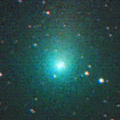
|
Now it is 10.9 mag (Apr. 13, Osamu Miyazaki). Fading gradually. It locates somewhat low in the Northern Hemisphere. But it will become high in summer. In the Southern Hemisphere, it is not observable now, but it will appear in May.
Date(TT) R.A. (2000) Decl. Delta r Elong. m1 Best Time(A, h)
Apr. 15 0 11.65 41 37.5 2.588 1.880 36 11.0 4:00 (230, 16)
Apr. 22 0 21.03 40 41.7 2.641 1.916 35 11.2 3:49 (231, 17)
|

|
It approached to Earth down to 0.29 a.u. in early February, and it brightened up to 4.5 mag (Feb. 1, Juan Jose Gonzalez). Now it is 11.9 mag (Apr. 13, Osamu Miyazaki). Fading rapidly. In the Northern Hemisphere, it will be unobservable soon. In the Southern Hemisphere, it will be getting lower gradually. But it will be getting higher again after July.
Date(TT) R.A. (2000) Decl. Delta r Elong. m1 Best Time(A, h)
Apr. 15 5 2.13 -9 35.4 2.167 1.809 55 11.3 20:00 ( 69, 12)
Apr. 22 5 7.42 -10 26.8 2.325 1.888 52 11.6 20:08 ( 73, 6)
|
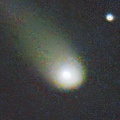
|
Now it is 12.0 mag (Apr. 9, Osamu Miyazaki). Fading slowly. In the Northern Hemisphere, it will be getting lower gradually after this, and it will be unobservable in July. In the Southern Hemisphere, it stays observable in good condition.
Date(TT) R.A. (2000) Decl. Delta r Elong. m1 Best Time(A, h)
Apr. 15 11 22.35 -2 13.3 2.742 3.627 147 11.4 21:48 ( 0, 53)
Apr. 22 11 9.91 -2 31.8 2.824 3.630 137 11.5 21:09 ( 0, 52)
|
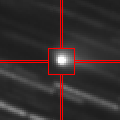
|
Now it is 13.3 mag (Mar. 28, Ken-ichi Kadota). It stays 11 mag for a while. It stays observable in good condition. It was expected to brighten up to 11 mag from spring to summer. However, it is fainter than expected recently.
Date(TT) R.A. (2000) Decl. Delta r Elong. m1 Best Time(A, h)
Apr. 15 19 14.60 -18 29.6 1.618 2.001 96 11.6 4:00 (331, 31)
Apr. 22 19 24.99 -17 5.1 1.544 1.995 100 11.4 3:49 (332, 33)
|
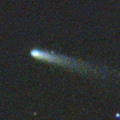
|
Now it is 11.9 mag (Apr. 12, Michael Jager). It will fade out rapidly after this. It will be fainter than 18 mag in July. In the Northern Hemisphere, it will be unobservable in May. But it will be observable again in June.
Date(TT) R.A. (2000) Decl. Delta r Elong. m1 Best Time(A, h)
Apr. 15 21 48.41 8 39.8 0.146 0.926 54 11.5 4:00 (278, 27)
Apr. 22 22 57.87 -1 25.2 0.204 0.877 46 11.5 3:49 (278, 10)
|

|
Now it is 12.6 mag (Mar. 21, Osamu Miyazaki). Fading gradually. It stays observable in good condition.
Date(TT) R.A. (2000) Decl. Delta r Elong. m1 Best Time(A, h)
Apr. 15 17 49.57 -18 40.6 1.305 1.972 116 12.5 4:00 (354, 36)
Apr. 22 17 51.57 -18 32.9 1.275 2.010 123 12.5 3:49 (359, 36)
|

|
It brightened up to 8.3 mag in last winter (Jan. 6, 2022, Toshiyuki Takahashi). Now it is 12.5 mag (Apr. 13, Osamu Miyazaki). Fading slowly. In the Northern Hemisphere, it will be unobservable in June. In the Southern Hemisphere, it stays observable in good condition.
Date(TT) R.A. (2000) Decl. Delta r Elong. m1 Best Time(A, h)
Apr. 15 9 1.78 -32 42.7 4.880 5.370 114 12.5 20:00 ( 7, 22)
Apr. 22 9 2.06 -32 13.2 4.985 5.413 110 12.6 20:08 ( 15, 21)
|

|
It is expected to brighten up to 8 mag in July. Now it is 14.5 mag (Feb. 16, Ken-ichi Kadota). It will brighten rapidly after this. In the Northern Hemisphere, it is not observable now, but it will appear in June. In the Southern Hemisphere, it will be getting higher gradually. At the high light, it will be observable in excellent condition in the Southern Hemisphere, but it will be very low in the Northern Hemisphere.
Date(TT) R.A. (2000) Decl. Delta r Elong. m1 Best Time(A, h)
Apr. 15 0 35.32 -10 45.7 2.958 2.086 24 13.0 4:00 (270,-19)
Apr. 22 0 37.49 -10 46.7 2.830 2.024 30 12.8 3:49 (272,-16)
|
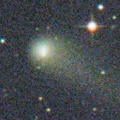
|
It brightened up to 11.1 mag in early 2022 (Mar. 31, 2022, F. Kugel, J.-G. Bosch, J. Nicolas). Now it is 13.2 mag (Mar. 31, Osamu Miyazaki). Fading slowly. It stays observable in good condition.
Date(TT) R.A. (2000) Decl. Delta r Elong. m1 Best Time(A, h)
Apr. 15 15 40.35 15 31.6 4.144 4.948 139 13.0 2:11 ( 0, 70)
Apr. 22 15 37.90 16 42.9 4.147 4.977 141 13.1 1:41 ( 0, 72)
|
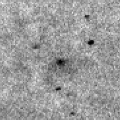
|
Now it is 13.4 mag (Apr. 7, Giuseppe Pappa). Fading slowly. In the Northern Hemisphere, it is not observable now, but it will be observable soon. In the Southern Hemisphere, it will be getting higher gradually.
Date(TT) R.A. (2000) Decl. Delta r Elong. m1 Best Time(A, h)
Apr. 15 22 51.66 -14 48.3 2.305 1.767 46 13.4 4:00 (288, -1)
Apr. 22 23 7.83 -13 26.9 2.288 1.795 48 13.5 3:49 (287, 0)
|

|
Now it is 13.0 mag (Mar. 25, Taras Prystavski). It stays 14 mag for a while. It will be unobservable in June. But it will be observable again in August in the Northern Hemisphere.
Date(TT) R.A. (2000) Decl. Delta r Elong. m1 Best Time(A, h)
Apr. 15 6 27.74 27 26.3 6.329 6.090 71 13.9 20:00 ( 92, 50)
Apr. 22 6 31.33 27 16.0 6.436 6.092 65 13.9 20:08 ( 96, 44)
|
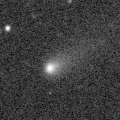
|
Now it is 14.5 mag (Apr. 7, Giuseppe Pappa). Fading slowly. It locates somewhat low in the Northern Hemisphere. In the Southern Hemisphere, it stays observable in good condition.
Date(TT) R.A. (2000) Decl. Delta r Elong. m1 Best Time(A, h)
Apr. 15 14 11.92 -28 18.8 1.387 2.350 158 14.0 0:43 ( 0, 27)
Apr. 22 14 3.45 -29 23.2 1.374 2.352 162 14.0 0:07 ( 0, 26)
|

|
The brightness evolution is slower than originally predicted. Now it is 14.6 mag (Mar. 18, Chris Wyatt). It stays 14 mag for a while. In the Northern Hemisphere, it is not observable now. It locates somewhat low in the Southern Hemisphere. But it will become high in winter.
Date(TT) R.A. (2000) Decl. Delta r Elong. m1 Best Time(A, h)
Apr. 15 4 15.99 -21 53.0 2.513 2.041 51 14.1 20:00 ( 66, -4)
Apr. 22 4 27.36 -22 53.5 2.517 2.035 50 14.0 20:08 ( 68, -9)
|
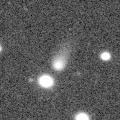
|
It is expected to brighten up to 7 mag in early 2024. Now it is 14.4 mag (Apr. 2, ATLAS Chile). Brightening slowly. In the Northern Hemisphere, it will be unobservable soon. In the Southern Hemisphere, it will be getting lower gradually. But it will be getting higher again after July.
Date(TT) R.A. (2000) Decl. Delta r Elong. m1 Best Time(A, h)
Apr. 15 5 30.00 -28 7.4 4.330 4.078 68 14.3 20:00 ( 51, 5)
Apr. 22 5 35.44 -27 18.8 4.312 4.009 65 14.2 20:08 ( 56, 1)
|
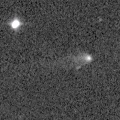
|
Now it is 14.9 mag (Mar. 19, Masayoshi Yoshimi). It stays 14 mag for a while. In the Northern Hemisphere, it is not observable now, but it will appear in June. In the Southern Hemisphere, it will be unobservable soon. But it will be observable again in May.
Date(TT) R.A. (2000) Decl. Delta r Elong. m1 Best Time(A, h)
Apr. 15 2 35.39 -2 33.3 4.183 3.259 20 14.7 20:00 ( 96,-13)
Apr. 22 2 36.49 -1 35.7 4.201 3.251 16 14.7 20:08 (102,-19)
|
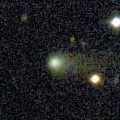
|
Now it is 15.3 mag (Apr. 10, Michael Jager). Fading slowly. In the Northern Hemisphere, it stays observable in good condition. It locates somewhat low in the Southern Hemisphere. But it will become high in winter.
Date(TT) R.A. (2000) Decl. Delta r Elong. m1 Best Time(A, h)
Apr. 15 9 28.66 29 19.3 2.948 3.424 110 14.9 20:00 ( 8, 84)
Apr. 22 9 32.71 29 7.2 3.047 3.436 104 15.0 20:08 ( 53, 80)
|
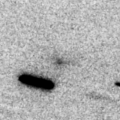
|
Now it is 15.4 mag (Apr. 2, E. Cortes, B. Lutkenhoner). It will fade out rapidly after this. It will be fainter than 18 mag in May. In the Northern Hemisphere, it will never be observable after this. It stays extremely low in the Southern Hemisphere.
Date(TT) R.A. (2000) Decl. Delta r Elong. m1 Best Time(A, h)
Apr. 15 23 55.38 -2 57.3 1.597 0.834 26 15.2 4:00 (269, -7)
Apr. 22 0 27.86 0 13.5 1.647 0.849 24 15.5 3:49 (264, -8)
|
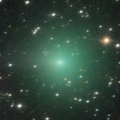
|
It brightened up to 9.7 mag in autumn (Oct. 23, Marco Goiato). Now it is 16.5 mag (Apr. 3, ATLAS South Africa). It will fade out rapidly after this. It will be fainter than 18 mag in June. It locates somewhat low in the Northern Hemisphere. In the Southern Hemisphere, it stays observable in good condition.
Date(TT) R.A. (2000) Decl. Delta r Elong. m1 Best Time(A, h)
Apr. 15 17 30.66 -45 21.2 1.701 2.341 117 15.2 4:00 ( 0, 10)
Apr. 22 16 57.17 -45 15.1 1.635 2.401 129 15.5 3:01 ( 0, 10)
|

|
It will brighten rapidly up to 13.5 mag in summer. Now it is 16.8 mag (Mar. 28, E. Cortes, B. Lutkenhoner). Brightening slowly. In the Northern Hemisphere, it is not observable now, but it will appear in June. In the Southern Hemisphere, it will be getting higher gradually.
Date(TT) R.A. (2000) Decl. Delta r Elong. m1 Best Time(A, h)
Apr. 15 23 43.78 -27 42.3 2.492 1.923 45 15.4 4:00 (292,-18)
Apr. 22 23 57.43 -24 56.5 2.428 1.891 46 15.3 3:49 (290,-16)
|

|
Now it is 15.1 mag (Mar. 31, Masayoshi Yoshimi). It stays 15 mag for a while. It will be getting lower gradually after this, and it will be unobservable in June in the Northern Hemisphere, or in July in the Southern Hemisphere. It is expected to brighten up to 12 mag from 2024 to 2025.
Date(TT) R.A. (2000) Decl. Delta r Elong. m1 Best Time(A, h)
Apr. 15 9 2.77 -7 38.1 5.275 5.755 113 15.3 20:00 ( 11, 47)
Apr. 22 8 59.88 -6 29.7 5.341 5.712 106 15.3 20:08 ( 25, 45)
|
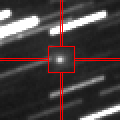
|
Brightened rapidly. Now it is 15.6 mag (Apr. 2, ATLAS South Africa). It will fade out rapidly after this. It will be fainter than 18 mag in July. In the Northern Hemisphere, it will be getting higher gradually. In the Southern Hemisphere, it stays observable in good condition.
Date(TT) R.A. (2000) Decl. Delta r Elong. m1 Best Time(A, h)
Apr. 15 12 10.65 -34 11.0 0.866 1.803 149 15.3 22:38 ( 0, 21)
Apr. 22 12 17.62 -28 34.3 0.881 1.828 151 15.4 22:18 ( 0, 27)
|
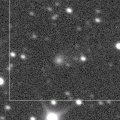
|
It will brighten up to 14 mag from 2024 to 2025. Now it is 15.4 mag (Apr. 3, ATLAS Chile). It stays 15 mag for a while. In the Northern Hemisphere, it will be unobservable in June. In the Southern Hemisphere, it stays observable in good condition.
Date(TT) R.A. (2000) Decl. Delta r Elong. m1 Best Time(A, h)
Apr. 15 8 44.72 -33 52.9 5.884 6.308 110 15.3 20:00 ( 11, 20)
Apr. 22 8 46.11 -33 4.2 5.913 6.277 106 15.3 20:08 ( 18, 19)
|
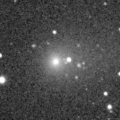
|
It brightened up to 12.4 mag in winter (Feb. 10, Taras Prystavski). Now it is 13.9 mag (Mar. 27, W. Pei). It will fade out rapidly after this. It will be fainter than 18 mag in July. It stays observable in good condition.
Date(TT) R.A. (2000) Decl. Delta r Elong. m1 Best Time(A, h)
Apr. 15 8 56.57 20 51.0 1.666 2.171 106 15.4 20:00 ( 31, 74)
Apr. 22 9 5.38 20 35.6 1.769 2.201 101 15.6 20:08 ( 47, 70)
|

|
It brightened up to 13.4 mag in last summer (July 7, Giuseppe Pappa). Now it is 15.9 mag (Mar. 28, P.-J. Dekelver). Fading slowly. In the Northern Hemisphere, it stays observable in good condition. In the Southern Hemisphere, it will be getting lower gradually.
Date(TT) R.A. (2000) Decl. Delta r Elong. m1 Best Time(A, h)
Apr. 15 17 51.58 16 46.0 3.135 3.609 110 15.4 4:00 (344, 71)
Apr. 22 17 44.24 19 23.6 3.095 3.647 115 15.4 3:47 ( 0, 74)
|
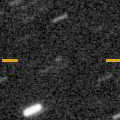
|
Now it is 16.5 mag (Mar. 18, Jean-Claude Merlin). Brightening slowly. It stays observable in good condition.
Date(TT) R.A. (2000) Decl. Delta r Elong. m1 Best Time(A, h)
Apr. 15 18 28.24 -15 40.7 2.566 3.023 107 15.6 4:00 (342, 38)
Apr. 22 18 31.65 -16 9.2 2.465 3.010 113 15.4 3:49 (346, 38)
|

|
Now it is 14.8 mag (Dec. 8, ATLAS Chile). It stays 15 mag for a while. In the Northern Hemisphere, it is not observable now, but it will appear in May. In the Southern Hemisphere, it will be getting higher gradually.
Date(TT) R.A. (2000) Decl. Delta r Elong. m1 Best Time(A, h)
Apr. 15 23 25.09 -11 25.8 4.067 3.329 37 15.4 4:00 (280, -5)
Apr. 22 23 33.75 -10 36.4 4.020 3.342 42 15.5 3:49 (281, -3)
|

|
Now it is 16.1 mag (Mar. 26, D. Buczynski). It stays 15 mag for a while. It stays observable in good condition. It is expected to brighten up to 12.5 mag in 2024 spring. At the high light, it will be observable in excellent condition in the Southern Hemisphere, but it will be low in the Northern Hemisphere.
Date(TT) R.A. (2000) Decl. Delta r Elong. m1 Best Time(A, h)
Apr. 15 18 25.55 19 55.3 3.953 4.272 101 15.7 4:00 (317, 71)
Apr. 22 18 19.87 20 38.9 3.808 4.222 107 15.6 3:49 (331, 74)
|
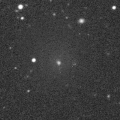
|
It will brighten up to 13 mag from June to August. Now it is 16.0 mag (Apr. 10, Michael Jager). Brightening gradually. In the Northern Hemisphere, it stays observable in good condition. In the Southern Hemisphere, it will be unobservable in May. But it will be observable again in August.
Date(TT) R.A. (2000) Decl. Delta r Elong. m1 Best Time(A, h)
Apr. 15 12 30.15 43 4.5 0.779 1.589 125 16.0 22:56 (180, 82)
Apr. 22 12 23.76 48 20.6 0.769 1.512 116 15.7 22:23 (180, 76)
|

|
It will brighten up to 13 mag in summer. Now it is 16.8 mag (Mar. 28, Thomas Lehmann). Brightening gradually. It locates somewhat low in the Northern Hemisphere. But it will become high in summer. In the Southern Hemisphere, it is not observable now, but it will appear in August.
Date(TT) R.A. (2000) Decl. Delta r Elong. m1 Best Time(A, h)
Apr. 15 2 13.58 65 9.8 2.048 1.707 56 15.9 20:00 (154, 24)
Apr. 22 2 11.14 64 18.8 2.061 1.653 52 15.8 20:08 (156, 20)
|

|
It brightened up to 9.6 mag in late January (Jan. 25, Toshihiko Ikemura, Hirohisa Sato). Now it is 14.1 mag (Mar. 19, Ken-ichi Kadota). Fading rapidly. It will be fainter than 18 mag in May. In the Northern Hemisphere, it will be getting lower gradually. In the Southern Hemisphere, it stays observable in good condition.
Date(TT) R.A. (2000) Decl. Delta r Elong. m1 Best Time(A, h)
Apr. 15 7 16.30 -5 44.4 1.610 1.858 87 15.8 20:00 ( 45, 38)
Apr. 22 7 27.48 -7 19.7 1.742 1.925 84 16.3 20:08 ( 50, 33)
|

|
It continued brightening even after the perihelion passage. Now it is 16.1 mag (Mar. 19, Ken-ichi Kadota). Fading gradually. It will be fainter than 18 mag in July. In the Northern Hemisphere, it will be getting lower gradually after this, and it will be unobservable in July. It locates somewhat low in the Southern Hemisphere.
Date(TT) R.A. (2000) Decl. Delta r Elong. m1 Best Time(A, h)
Apr. 15 7 53.01 25 9.3 2.648 2.847 90 16.1 20:00 ( 72, 66)
Apr. 22 8 0.39 24 51.3 2.764 2.872 85 16.3 20:08 ( 78, 61)
|

|
Now it is 16.0 mag (Mar. 31, Ken-ichi Kadota). It stays 16 mag for a while. In the Northern Hemisphere, it will be getting lower gradually after this, and it will be unobservable in June. In the Southern Hemisphere, it stays observable in good condition.
Date(TT) R.A. (2000) Decl. Delta r Elong. m1 Best Time(A, h)
Apr. 15 8 25.25 -8 2.9 3.613 3.988 104 16.3 20:00 ( 24, 44)
Apr. 22 8 22.28 -8 20.3 3.700 3.966 97 16.3 20:08 ( 35, 40)
|
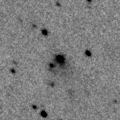
|
It approached to Sun down to 0.1 a.u. on Jan. 31. It was bright as 7.0-7.5 mag in early February (Feb. 5, Michael Jager). Now it is 14.9 mag (Apr. 3, Ken-ichi Kadota). Fading rapidly. It will be fainter than 18 mag in June. It stays observable in good condition.
Date(TT) R.A. (2000) Decl. Delta r Elong. m1 Best Time(A, h)
Apr. 15 20 15.95 -9 15.6 1.547 1.699 80 16.4 4:00 (310, 31)
Apr. 22 20 11.30 -9 48.1 1.523 1.802 88 16.7 3:49 (316, 34)
|

|
Now it is 16.9 mag (Mar. 19, Toshihiko Ikemura, Hirohisa Sato). Fading slowly. It will be fainter than 18 mag in August. In the Northern Hemisphere, it stays observable in good condition. It locates somewhat low in the Southern Hemisphere.
Date(TT) R.A. (2000) Decl. Delta r Elong. m1 Best Time(A, h)
Apr. 15 8 35.02 26 21.3 1.839 2.241 99 16.6 20:00 ( 58, 75)
Apr. 22 8 43.14 25 36.7 1.911 2.236 95 16.6 20:08 ( 68, 70)
|

|
It brightened up to 9.3 mag in early summer in 2022 (June 5, Chris Wyatt). Now it is 16.6 mag (Mar. 31, ATLAS South Africa). Fading gradually. It will be fainter than 18 mag in June. In the Northern Hemisphere, it will be getting lower gradually after this, and it will be unobservable in May. In the Southern Hemisphere, it will be getting lower gradually.
Date(TT) R.A. (2000) Decl. Delta r Elong. m1 Best Time(A, h)
Apr. 15 6 43.40 -8 31.5 4.039 3.987 79 16.6 20:00 ( 51, 31)
Apr. 22 6 45.50 -7 1.4 4.206 4.051 74 16.8 20:08 ( 59, 27)
|
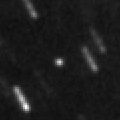
|
It will approach to Sun down to 0.4 a.u. in late September in 2024, and it is expected to brighten up to 0 mag. Now it is 16.9 mag (Apr. 11, Michael Jager). It stays 16 mag for a while. It stays observable in good condition. At the high light, in the Northern Hemisphere, it will be observable in good condition after the perihelion passage. In the Southern Hemisphere, it will be observable in the low sky before and after the perihelion passage.
Date(TT) R.A. (2000) Decl. Delta r Elong. m1 Best Time(A, h)
Apr. 15 15 2.56 1 19.8 5.934 6.854 154 16.7 1:33 ( 0, 56)
Apr. 22 14 57.91 1 43.0 5.840 6.790 159 16.7 1:01 ( 0, 57)
|
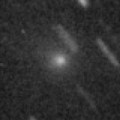
|
It brightened up to 11 mag in SWAN images in January (Jan. 23, Vladimir Bezugly). Now it is 16.3 mag (Apr. 1, iTelescope Observatory, Siding Spring). Fading rapidly. It will be fainter than 18 mag in May. In the Northern Hemisphere, it will never be observable after this. In the Southern Hemisphere, it stays observable in good condition.
Date(TT) R.A. (2000) Decl. Delta r Elong. m1 Best Time(A, h)
Apr. 15 23 3.01 -56 27.8 1.701 1.697 72 16.7 4:00 (323,-25)
Apr. 22 23 40.41 -60 21.0 1.714 1.785 77 17.2 3:49 (325,-29)
|
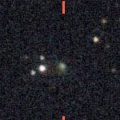
|
It brightened rapidly up to 15.8 mag (Mar. 19, Toshihiko Ikemura, Hirohisa Sato). Now it is 17 mag (Apr. 9, Giuseppe Pappa). It will fade out rapidly after this. It will be fainter than 18 mag in May. In the Northern Hemisphere, it will be getting lower gradually. It locates somewhat low in the Southern Hemisphere.
Date(TT) R.A. (2000) Decl. Delta r Elong. m1 Best Time(A, h)
Apr. 15 7 14.77 28 30.5 1.719 1.867 82 16.8 20:00 ( 87, 60)
Apr. 22 7 16.07 24 14.6 1.856 1.885 76 17.0 20:08 ( 85, 51)
|

|
Very far object. Now it is 16.7 mag (Mar. 29, ATLAS Chile). It stays 17 mag for a while. In the Northern Hemisphere, it is not observable now. In the Southern Hemisphere, it stays observable in good condition.
Date(TT) R.A. (2000) Decl. Delta r Elong. m1 Best Time(A, h)
Apr. 15 4 56.91 -69 30.0 10.389 10.377 86 16.8 20:00 ( 21,-26)
Apr. 22 4 58.52 -68 59.6 10.377 10.372 86 16.8 20:08 ( 23,-28)
|
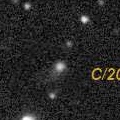
|
Now it is 16.5 mag (Mar. 31, ATLAS South Africa). It stays 17 mag for a while. It stays observable in good condition.
Date(TT) R.A. (2000) Decl. Delta r Elong. m1 Best Time(A, h)
Apr. 15 12 49.70 12 22.3 8.034 8.959 155 16.8 23:16 ( 0, 67)
Apr. 22 12 45.17 12 49.2 8.085 8.966 149 16.9 22:44 ( 0, 68)
|

|
It brightened up to 13.6 mag in 2021 (June 17, 2021, R. Carstens). Now it is 17.4 mag (Apr. 3, ATLAS South Africa). It stays 17 mag for a while. In the Northern Hemisphere, it will never be observable after this. In the Southern Hemisphere, it stays observable in good condition.
Date(TT) R.A. (2000) Decl. Delta r Elong. m1 Best Time(A, h)
Apr. 15 12 57.03 -73 48.8 5.884 6.380 115 16.9 23:22 ( 0,-19)
Apr. 22 12 34.49 -73 29.6 5.888 6.412 117 16.9 22:32 ( 0,-19)
|

|
It has not been observed yet in this apparition. It will brighten up to 11 mag in July. Brightening rapidly. It stays extremely low in the Northern Hemisphere. But it will become high in autumn. It locates somewhat low in the Southern Hemisphere.
Date(TT) R.A. (2000) Decl. Delta r Elong. m1 Best Time(A, h)
Apr. 15 22 22.63 1 12.0 2.023 1.535 47 17.4 4:00 (279, 15)
Apr. 22 22 44.52 3 21.7 1.930 1.468 48 16.9 3:49 (276, 15)
|

|
Now it is 17.1 mag (Mar. 31, Ken-ichi Kadota). It stays 17 mag for a while. In the Northern Hemisphere, it stays observable in good condition. In the Southern Hemisphere, it is not observable now, but it will appear in May.
Date(TT) R.A. (2000) Decl. Delta r Elong. m1 Best Time(A, h)
Apr. 15 13 6.65 55 52.7 2.552 3.104 114 16.9 23:33 (180, 69)
Apr. 22 13 3.87 56 17.7 2.575 3.080 110 16.9 23:03 (180, 69)
|

|
It brightened up to 12.7 mag in last year (Feb. 27, 2022, Jose Guilherme de S. Aguiar). Now it is 17.1 mag (Mar. 17, Jean-Claude Merlin). Fading slowly. It will be fainter than 18 mag in August. It locates somewhat low in the Northern Hemisphere. In the Southern Hemisphere, it stays observable in good condition.
Date(TT) R.A. (2000) Decl. Delta r Elong. m1 Best Time(A, h)
Apr. 15 19 51.48 -24 42.7 2.661 2.832 89 16.9 4:00 (326, 22)
Apr. 22 19 57.03 -24 37.9 2.591 2.857 94 17.0 3:49 (328, 23)
|
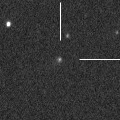
|
Now it is 17.8 mag (Apr. 10, Michael Jager). It stays 17 mag for a while. In the Northern Hemisphere, it stays observable in good condition. It locates somewhat low in the Southern Hemisphere.
Date(TT) R.A. (2000) Decl. Delta r Elong. m1 Best Time(A, h)
Apr. 15 9 15.89 36 4.3 2.117 2.564 104 17.2 20:00 (107, 87)
Apr. 22 9 20.80 35 14.0 2.186 2.555 99 17.2 20:08 ( 94, 80)
|
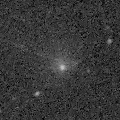
|
Very large comet. It is expected to brighten up to 14 mag in 2031. Now it is 17.1 mag (Mar. 13, ATLAS Chile). It stays 17 mag for a while. In the Northern Hemisphere, it is not observable now. In the Northern Hemisphere, it is not observable until 2030.
Date(TT) R.A. (2000) Decl. Delta r Elong. m1 Best Time(A, h)
Apr. 15 2 47.68 -57 20.9 18.116 17.776 68 17.3 20:00 ( 40,-35)
Apr. 22 2 50.67 -57 17.0 18.067 17.750 70 17.3 20:08 ( 41,-39)
|
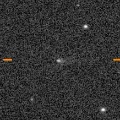
|
Now it is 16.7 mag (Mar. 29, Masayoshi Yoshimi). It will fade out rapidly after this. It will be fainter than 18 mag in May. It stays observable in good condition.
Date(TT) R.A. (2000) Decl. Delta r Elong. m1 Best Time(A, h)
Apr. 15 13 24.74 25 37.2 0.570 1.505 144 17.3 23:51 ( 0, 80)
Apr. 22 13 21.93 23 28.9 0.622 1.550 143 17.6 23:21 ( 0, 78)
|

|
It returns for the first time in 70 years. It will brighten up to 4.5 mag in 2024 spring. Now it is 17.9 mag (Apr. 3, Ken-ichi Kadota). Brightening gradually. In the Northern Hemisphere, it stays observable in good condition. In the Southern Hemisphere, it will be unobservable in July.
Date(TT) R.A. (2000) Decl. Delta r Elong. m1 Best Time(A, h)
Apr. 15 19 34.80 38 34.3 4.838 4.825 83 17.7 4:00 (253, 65)
Apr. 22 19 36.07 40 9.0 4.719 4.760 86 17.5 3:49 (248, 68)
|

|
Now it is 17.1 mag (Mar. 28, ATLAS-HKO, Haleakala). It stays 18 mag for a while. In the Northern Hemisphere, it stays observable in good condition. In the Southern Hemisphere, it will never be observable after this.
Date(TT) R.A. (2000) Decl. Delta r Elong. m1 Best Time(A, h)
Apr. 15 18 23.76 75 50.1 9.900 9.860 84 17.6 4:00 (185, 49)
Apr. 22 18 17.05 76 44.0 9.935 9.878 83 17.6 3:49 (182, 48)
|
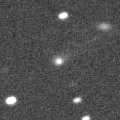
|
It brightened up to 15.9 mag in 2022 spring (May 5, Toshiyuki Takahashi). Now it is 17.4 mag (Mar. 30, J. L. Virlichie, P. Traverse, H. Roy, G. Houdin). It stays 18 mag for a while. It stays observable in good condition.
Date(TT) R.A. (2000) Decl. Delta r Elong. m1 Best Time(A, h)
Apr. 15 16 29.64 -24 39.5 4.143 4.902 134 17.6 3:00 ( 0, 30)
Apr. 22 16 27.68 -24 41.5 4.077 4.909 142 17.6 2:31 ( 0, 30)
|
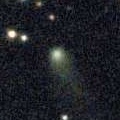
|
Now it is 17.3 mag (Mar. 10, Catalina Sky Survey). It stays 18 mag for a while. In the Northern Hemisphere, it stays observable in good condition. In the Southern Hemisphere, it will never be observable after this.
Date(TT) R.A. (2000) Decl. Delta r Elong. m1 Best Time(A, h)
Apr. 15 18 52.79 56 50.4 6.355 6.384 87 17.6 4:00 (206, 64)
Apr. 22 18 53.95 58 2.7 6.376 6.419 87 17.6 3:49 (200, 64)
|
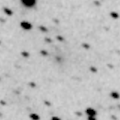
|
Now it is 17.4 mag (Apr. 3, E. Cortes). Fading slowly. It will be fainter than 18 mag in May. In the Northern Hemisphere, it will be getting higher gradually. In the Southern Hemisphere, it stays observable in good condition. Michael Jager reported it is very bright as 15.8 mag on Apr. 12.
Date(TT) R.A. (2000) Decl. Delta r Elong. m1 Best Time(A, h)
Apr. 15 21 29.99 3 47.2 2.370 2.060 59 17.6 4:00 (285, 27)
Apr. 22 21 39.75 6 8.8 2.346 2.101 63 17.7 3:49 (284, 29)
|

|
It brightened very rapidly up to 15.5 mag from last autumn to last winter (Nov. 2, 2021, Toshihiko Ikemura, Hirohisa Sato). Now it is 17.4 mag (Apr. 9, Giuseppe Pappa). It stays 18 mag for a while. It will be getting lower gradually.
Date(TT) R.A. (2000) Decl. Delta r Elong. m1 Best Time(A, h)
Apr. 15 6 28.78 11 39.6 4.982 4.788 73 17.6 20:00 ( 72, 42)
Apr. 22 6 33.50 11 45.9 5.103 4.810 67 17.7 20:08 ( 78, 36)
|
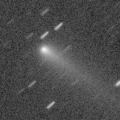
|
It brightened up to 14.1 mag in autumn (Nov. 14, Thomas Lehmann). Now it is 17.6 mag (Mar. 30, Catalina Sky Survey). Fading slowly. It will be fainter than 18 mag in May. It locates somewhat low in the Northern Hemisphere. In the Southern Hemisphere, it will never be observable after this.
Date(TT) R.A. (2000) Decl. Delta r Elong. m1 Best Time(A, h)
Apr. 15 4 33.57 37 41.7 3.353 2.812 49 17.6 20:00 (117, 32)
Apr. 22 4 47.80 38 5.5 3.443 2.841 46 17.7 20:08 (119, 28)
|
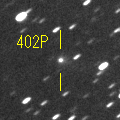
|
It brightened up to 15.3 mag in last winter (Jan. 12, 2022, Hidenori Nohara). Now it is 17.6 mag (Mar. 19, ATLAS-HKO, Haleakala). Fading slowly. It will be fainter than 18 mag in May. In the Northern Hemisphere, it stays observable in good condition. It locates somewhat low in the Southern Hemisphere.
Date(TT) R.A. (2000) Decl. Delta r Elong. m1 Best Time(A, h)
Apr. 15 9 50.41 31 20.0 4.274 4.762 113 17.6 20:18 ( 0, 86)
Apr. 22 9 50.91 31 15.2 4.390 4.782 107 17.7 20:08 ( 44, 85)
|

|
It was regarded as an asteroid, but its cometary activity was detected. Now it is 17.9 mag (Apr. 10, Michael Jager). It will fade out rapidly after this. It will be fainter than 18 mag soon. In the Northern Hemisphere, it will be getting lower gradually. In the Southern Hemisphere, it stays observable in good condition.
Date(TT) R.A. (2000) Decl. Delta r Elong. m1 Best Time(A, h)
Apr. 15 6 39.16 16 13.0 1.384 1.486 75 17.6 20:00 ( 75, 47)
Apr. 22 7 2.51 15 38.6 1.447 1.517 73 17.8 20:08 ( 77, 45)
|

|
Brightening slowly. It locates somewhat low in the Northern Hemisphere. But it will become high in summer. In the Southern Hemisphere, it stays observable in good condition.
Date(TT) R.A. (2000) Decl. Delta r Elong. m1 Best Time(A, h)
Apr. 15 21 55.94 -10 32.5 3.491 3.063 57 17.8 4:00 (293, 13)
Apr. 22 22 4.95 -10 3.9 3.406 3.058 61 17.7 3:49 (293, 14)
|
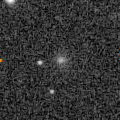
|
It moves along an almost circular orbit. It brightened up to 16.2 mag temporarily in outburst (Jan. 27, Toshihiko Ikemura, Hirohisa Sato). Now it is 17.1 mag (Mar. 29, Masayoshi Yoshimi). Fading gradually. It will be fainter than 18 mag soon. In the Northern Hemisphere, it stays observable in good condition. It locates somewhat low in the Southern Hemisphere.
Date(TT) R.A. (2000) Decl. Delta r Elong. m1 Best Time(A, h)
Apr. 15 10 36.79 26 5.5 5.513 6.141 124 17.9 21:04 ( 0, 81)
Apr. 22 10 35.71 25 56.0 5.602 6.141 118 18.1 20:35 ( 0, 81)
|

|
It was predicted to brighten up to 16 mag in 2023. But actually, it is very faint as 18.1 mag (Mar. 29, ATLAS Chile). It stays 18 mag for a while. In the Northern Hemisphere, it is not observable now. In the Southern Hemisphere, it stays observable in good condition.
Date(TT) R.A. (2000) Decl. Delta r Elong. m1 Best Time(A, h)
Apr. 15 20 24.71 -75 34.7 3.040 3.297 95 18.0 4:00 (349,-24)
Apr. 22 20 40.41 -75 51.2 3.002 3.310 98 18.0 3:49 (349,-24)
|
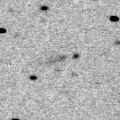
|
Now it is 19.3 mag (Mar. 27, A. Diepvens). Fading slowly. It stays observable in good condition. It looks elongated.
Date(TT) R.A. (2000) Decl. Delta r Elong. m1 Best Time(A, h)
Apr. 15 10 4.94 16 28.5 3.548 4.179 122 18.5 20:32 ( 0, 71)
Apr. 22 10 5.39 16 25.7 3.636 4.178 116 18.6 20:08 ( 2, 71)
|
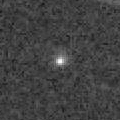
|
It was observed at 17 mag in 2022 autumn. It was predicted to be observable at 17 mag also in 2023 spring. But actually, it is extremely faint as 19.7 mag (Apr. 1, Taras Prystavski). It will fade out rapidly after this. It stays observable in good condition.
Date(TT) R.A. (2000) Decl. Delta r Elong. m1 Best Time(A, h)
Apr. 15 19 50.90 11 6.6 1.732 1.897 83 19.6 4:00 (298, 50)
Apr. 22 19 33.24 13 49.7 1.615 1.942 92 19.6 3:49 (305, 58)
|
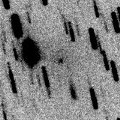
|
Tiny comet, but it approached to Sun down to 0.8 a.u. in January, and it will approach to Earth down to 0.6 a.u. in March. It was expected to brighten up to 14 mag from January to March. But actually, it became disintegrated before the perihelion passage. Now it is extremely faint as 18.2 mag (Feb. 20, Thomas Lehmann). Fading rapidly. In the Northern Hemisphere, it stays observable in good condition. In the Southern Hemisphere, it will be getting lower gradually.
Date(TT) R.A. (2000) Decl. Delta r Elong. m1 Best Time(A, h)
Apr. 15 8 5.86 17 2.9 1.237 1.666 95 21.3 20:00 ( 53, 64)
Apr. 22 8 20.31 20 20.2 1.421 1.759 91 21.8 20:08 ( 65, 62)
|

|
In the last apparition, it had faded before the perihelion passage. It was expected to brighten up to 17 mag if it would become as bright as its last apparition. But actually, it is extremely faint as 22 mag (Apr. 8, Giuseppe Pappa). It stays 22 mag for a while. It stays observable in good condition.
Date(TT) R.A. (2000) Decl. Delta r Elong. m1 Best Time(A, h)
Apr. 15 14 5.69 6 10.8 1.775 2.747 162 21.6 0:36 ( 0, 61)
Apr. 22 14 1.67 6 45.5 1.763 2.734 161 21.6 0:05 ( 0, 62)
|
|
![]()
 C/2022 E2 ( ATLAS )
C/2022 E2 ( ATLAS ) C/2023 B2 ( ATLAS )
C/2023 B2 ( ATLAS ) C/2021 G2 ( ATLAS )
C/2021 G2 ( ATLAS ) 118P/Shoemaker-Levy 4
118P/Shoemaker-Levy 4 C/2020 R7 ( ATLAS )
C/2020 R7 ( ATLAS ) 199P/Shoemaker 4
199P/Shoemaker 4 117P/Helin-Roman-Alu 1
117P/Helin-Roman-Alu 1 C/2022 L2 ( ATLAS )
C/2022 L2 ( ATLAS ) C/2023 E1 ( ATLAS )
C/2023 E1 ( ATLAS ) C/2022 W3 ( Leonard )
C/2022 W3 ( Leonard ) C/2022 U2 ( ATLAS )
C/2022 U2 ( ATLAS ) 119P/Parker-Hartley
119P/Parker-Hartley C/2022 A3 ( Lemmon-ATLAS )
C/2022 A3 ( Lemmon-ATLAS ) 96P/Machholz 1
96P/Machholz 1 94P/Russell 4
94P/Russell 4 C/2021 E3 ( ZTF )
C/2021 E3 ( ZTF ) C/2023 A3 ( Tsuchinshan-ATLAS )
C/2023 A3 ( Tsuchinshan-ATLAS ) C/2023 A2 ( SWAN )
C/2023 A2 ( SWAN ) C/2023 A1 ( Leonard )
C/2023 A1 ( Leonard ) C/2019 E3 ( ATLAS )
C/2019 E3 ( ATLAS ) C/2020 F2 ( ATLAS )
C/2020 F2 ( ATLAS ) C/2018 U1 ( Lemmon )
C/2018 U1 ( Lemmon ) 185P/Petriew
185P/Petriew C/2022 U4 ( Bok )
C/2022 U4 ( Bok ) 116P/Wild 4
116P/Wild 4 180P/NEAT
180P/NEAT C/2014 UN271 ( Bernardinelli-Bernstein )
C/2014 UN271 ( Bernardinelli-Bernstein ) 263P/Gibbs
263P/Gibbs 12P/Pons-Brooks
12P/Pons-Brooks C/2019 O3 ( Palomar )
C/2019 O3 ( Palomar ) 99P/Kowal 1
99P/Kowal 1 C/2020 H6 ( ATLAS )
C/2020 H6 ( ATLAS ) 80P/Peters-Hartley
80P/Peters-Hartley P/2021 N2 ( Fuls )
P/2021 N2 ( Fuls ) P/2022 L3 ( ATLAS )
P/2022 L3 ( ATLAS ) 402P/2020 Q3 ( LINEAR )
402P/2020 Q3 ( LINEAR ) P/2010 VH95 ( Catalina )
P/2010 VH95 ( Catalina ) 287P/Christensen
287P/Christensen P/2023 B1 ( PanSTARRS )
P/2023 B1 ( PanSTARRS ) C/2021 C5 ( PanSTARRS )
C/2021 C5 ( PanSTARRS ) 452P/2022 B5 ( Sheppard-Jewitt )
452P/2022 B5 ( Sheppard-Jewitt ) C/2022 Q2 ( ATLAS )
C/2022 Q2 ( ATLAS ) C/2022 S3 ( PanSTARRS )
C/2022 S3 ( PanSTARRS ) 280P/Larsen
280P/Larsen![]()





























































